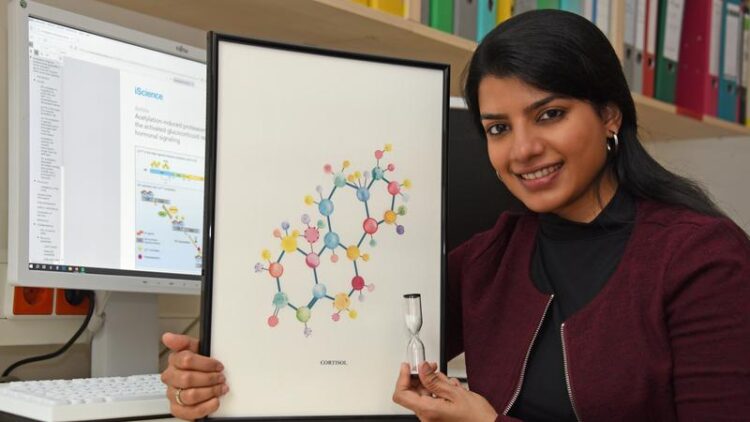Acetylation: a Time-Keeper of glucocorticoid Sensitivity

Dr. Aishwarya Iyer-Bierhoff has discovered a molecular “hourglass” for cortisol action.
(c) Anne Günther/University Jena
Understanding the regulatory mechanism paves the way to enhance the effectiveness of anti-inflammatory therapies and to develop strategies to counteract the negative effects of stress- and age-related cortisol excess. The research group led by Prof. Thorsten Heinzel at the Friedrich Schiller University Jena, together with researchers from the Leibniz Institute on Aging – Fritz Lipmann Institute (FLI) in Jena and the University of Ulm, have now been able to clarify an important aspect of cortisol resistance. The study was funded by the Carl Zeiss Foundation as part of the IMPULS research consortium and was recently published in the journal “iScience”.
Jena/Ulm. Cortisol, also commonly known as the stress hormone, belongs to the family of glucocorticoids. In addition to its physiological function, synthetic derivatives of cortisol are also used as anti-inflammatory drugs. In the cell, the hormone acts by binding to the glucocorticoid receptor (GR), which then acts as a transcription factor to regulate the activity of certain target genes. In order to switch off the cortisol signal again, the cell breaks down the cortisol-bound GR over time. Therefore, chronic stress or long-term hormone therapy can deplete the cellular GR supply and lead to a loss of sensitivity to cortisol. The molecular mechanisms that lead to this cortisol resistance are still largely unknown.
The research group led by Prof. Thorsten Heinzel at the Friedrich Schiller University Jena, together with researchers from the Leibniz Institute on Aging – Fritz Lipmann Institute (FLI) in Jena and the University of Ulm, have now been able to clarify an important aspect of cortisol resistance. The study was funded by the Carl Zeiss Foundation as part of the IMPULS research consortium and was recently published in the journal “iScience”.
The Proteomics Technology Unit of the FLI was also crucial to the project, providing support with mass spectrometry to investigate the exact molecular composition of the GR. This revealed a chemical modification, known as acetylation, which only occurs when the GR is bound to cortisol. However, this acetylation does not change the function of GR as a transcription factor, as observed from the measurement of gene activity by RNA sequencing, which was also carried out at the FLI by the Next Generation sequencing Core facility. However, further investigations showed that the modified GR is less stable and is degraded more quickly. “This finding suggests that the cell can adjust its response to cortisol by acetylating GR. Simply put, higher levels of acetylation, shorten the effect of cortisol”, explains Dr. Aishwarya Iyer-Bierhoff, the first author of the study.
Elucidation of this regulatory mechanism opens up new possibilities for counteracting cortisol resistance in order to improve the efficacy of anti-inflammatory therapies. In addition, new strategies can be developed to counteract the negative effects of stress- and age-related excess cortisol.
The Leibniz Institute on Aging – Fritz Lipmann Institute (FLI) – upon its inauguration in 2004 – was the first German research organization dedicated to research on the process of aging. Around 350 employees from around 40 nations explore the molecular mechanisms underlying aging processes and age-associated diseases. For more information, please visit www.leibniz-fli.de.
The Leibniz Association connects 97 independent research institutions that range in focus from natural, engineering, and environmental sciences to economics, spatial, and social sciences and the humanities. Leibniz Institutes address issues of social, economic, and ecological relevance. They conduct basic and applied research, including in the interdisciplinary Leibniz Research Alliances, maintain scientific infrastructure, and provide research-based services. The Leibniz Association identifies focus areas for knowledge transfer, particularly with the Leibniz research museums. It advises and informs policymakers, science, industry, and the general public. Leibniz institutions collaborate intensively with universities – including in the form of Leibniz ScienceCampi – as well as with industry and other partners at home and abroad. They are subject to a transparent, independent evaluation procedure. Because of their importance for the country as a whole, the Leibniz Association Institutes are funded jointly by Germany’s central and regional governments. The Leibniz Institutes employ around 20,500 people, including 11,500 researchers. The financial volume amounts to 2 billion euros. For more information: www.leibniz-gemeinschaft.de/en/.
Wissenschaftliche Ansprechpartner:
aishwarya.iyer-bierhoff@uni-jena.de
Originalpublikation:
Aishwarya Iyer-Bierhoff, Martin Wieczorek, Sina Marielle Peter, Dima Ward, Martin Bens, Sabine Vettorazzi, Karl-Heinz Guehrs, Jan P. Tuckermann, Thorsten Heinzel. Acetylation-induced proteasomal degradation of the activated glucocorticoid receptor limits hormonal signaling, iScience, Volume 27, Issue 2, 2024.
https://doi.org/10.1016/j.isci.2024.108943
https://www.sciencedirect.com/science/article/pii/S2589004224001640
Media Contact
All latest news from the category: Life Sciences and Chemistry
Articles and reports from the Life Sciences and chemistry area deal with applied and basic research into modern biology, chemistry and human medicine.
Valuable information can be found on a range of life sciences fields including bacteriology, biochemistry, bionics, bioinformatics, biophysics, biotechnology, genetics, geobotany, human biology, marine biology, microbiology, molecular biology, cellular biology, zoology, bioinorganic chemistry, microchemistry and environmental chemistry.
Newest articles

First-of-its-kind study uses remote sensing to monitor plastic debris in rivers and lakes
Remote sensing creates a cost-effective solution to monitoring plastic pollution. A first-of-its-kind study from researchers at the University of Minnesota Twin Cities shows how remote sensing can help monitor and…

Laser-based artificial neuron mimics nerve cell functions at lightning speed
With a processing speed a billion times faster than nature, chip-based laser neuron could help advance AI tasks such as pattern recognition and sequence prediction. Researchers have developed a laser-based…

Optimising the processing of plastic waste
Just one look in the yellow bin reveals a colourful jumble of different types of plastic. However, the purer and more uniform plastic waste is, the easier it is to…



